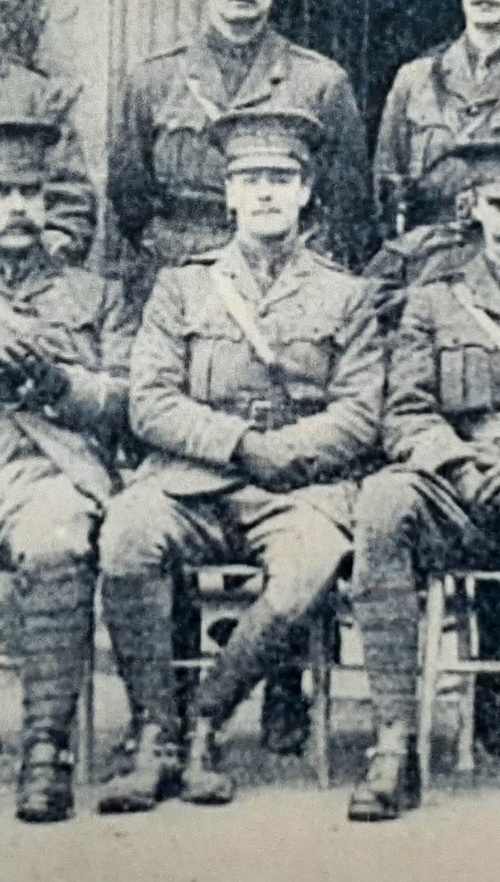Auction: 22103 - Orders, Decorations and Medals VII - e-Auction
Lot: 438
Three: Major R. E. C. Knight-Bruce, Royal Air Force, late Royal Naval Air Service, Royal Flying Corps and Devon Yeomanry who saw service at Gallipoli before joining the Royal Flying Corps, attached Royal Naval Air Service as Air-Commodore C. R. Samon's Observer during the hunt for the Q-Ship Wolf
1914-15 Star (Capt. R. E. Knight Bruce R. 1-Devon Yeo.); British War and Victory Medals (Capt. R. E. C. Knight-Bruce.), good very fine (3)
Robert Evelyn Cleave Knight-Bruce was born at Shobrooke, Devon on 16 September 1890, the son of John and Charity Knight-Bruce of Elm Cottage, Tiverton. Young Knight-Bruce was educated at Marlborough from 1904-1908 before attending Trinity College, Cambridge. While starting his studies he also joined the local Yeomanry, receiving a commission and serving as 2nd Lieutenant in the Devon Yeomanry on 9 February 1909. Promoted Lieutenant on 26 June 1912 Knight-Bruce also earned his BA in September of that year.
Advanced Captain on 5 August 1914 with 1st Battalion, Devon Yeomanry Knight-Bruce joined the war with this unit at Gallipoli on 9 October 1915. Attached to 2nd Mounted Division- although serving dismounted- they entered the firing line in November. Evacuated in December the unit made its way to Egypt where they served from 30 December 1915. They served at times on the Suez Canal defences and also with the Western Frontier Force combating the efforts of the Senussi.
Knight-Bruce was seconded to the Royal Flying Corps in June 1916 and between June and August he took wireless and air gunnery courses as well as Staff Corps Training. Posted to No. 47 Squadron at Salonica on 28 August 1916 and serving between Salonica and Egypt for the next year. Seconded to the Royal Naval Air Service as a Flying Officer (Observer) on 22 February 1917 he acted as Observer to Air-Commodore R. C. Samson aboard H.M.S. Raven II during their hunt for the German Q-Ship Wolf. Samson's Fights and Flights refers to this stating:
'We sailed on March 19th, and after passing Socotra Island ran into very fine weather. On the 22nd I was hoisted out in mid-ocean on board the Experimental Short, carrying Captain Knight-Bruce as my observer. The Short in the very heavy swell left the water in fine style, after one or two very anxious moments, and we set off to make a sweep on a radius of about 50 miles from the ships.
It was a lonely feeling, once we lost sight of our Squadron, as the Indian Ocean is a large space and no ship was in sight. After completing our journey, I returned to what I had estimated would be the new position of the Raven, allowing for her speed, and I was a little relieved to discover that my navigation was correct. As a matter of fact, I saw her when still about 20 miles away. Landing was difficult, as the swell was very heavy, but I managed it safely by getting down just below the crest of a wave.'
Back in Egypt in June 1917 Knight-Bruce was pronounced unfit to fly. He had for some time been suffering from Malaria with the first symptoms apparently starting while he was still in Salonica. A particularly unfortunate side effect appeared to be the tendency to vomit while flying, a dangerous habit compounded by severe headaches on landing. Returning to Britain for treatment he was further pronounced fit for ground duties only he was posted to the School of Technical Training as Section Commander and promoted Temporary Major for the duration of his duties there. Knight-Bruce was finally transferred to the unemployed list on 23 February 1919.
The outbreak of the Second World War brought Knight-Bruce back to Military Service and he was commissioned Pilot Officer with the Administration and Special Duties Branch on 26 September 1939. Further advanced Flying Officer on 19 September 1940 but resigned his commission only a few days later on 28 September. Despite this he remained active with the services and was commissioned 2nd Lieutenant with the Army Cadet Force on 27 April 1946 as part of Devon Command. Knight-Bruce died on 12 August 1960 at Exeter, Devon; sold together with handwritten research as well as census data, London Gazette entries and service records along with M.I.C., an extract form Fights and Flights and a copied photograph of the recipient in the uniform of the Devon Yeomanry.
Subject to 20% VAT on Buyer’s Premium. For more information please view Terms and Conditions for Buyers.
Sold for
£270
Starting price
£110









